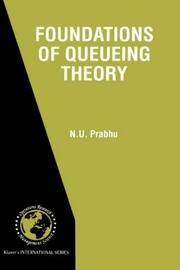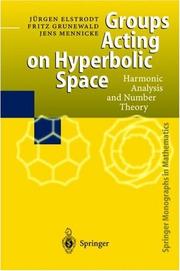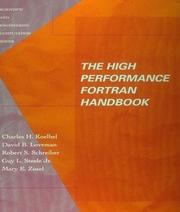| Listing 1 - 5 of 5 |
Sort by
|
Multi
ISBN: 9173463213 Year: 1997 Publisher: Göteborg Acta universitatis Gothoburgensis
Abstract | Keywords | Export | Availability | Bookmark
 Loading...
Loading...Choose an application
- Reference Manager
- EndNote
- RefWorks (Direct export to RefWorks)
Mole (Chemistry) --- Study and teaching. --- Gram-atom --- Gram-atomic weight --- Gram-formula weight --- Gram-molecular weight --- Gram-molecule --- Molecular theory --- Study and teaching --- Theses

ISBN: 0792399625 9780792399629 Year: 1997 Publisher: Boston (Mass.) : Kluwer academic,
Abstract | Keywords | Export | Availability | Bookmark
 Loading...
Loading...Choose an application
- Reference Manager
- EndNote
- RefWorks (Direct export to RefWorks)
Queuing theory. --- 519.872 --- Queuing theory --- Erlang traffic formula --- Queueing theory --- Theory of queues --- Waiting-line theory --- Production scheduling --- Stochastic processes --- Queuing theory. Service systems. Numerical simulation --- 519.872 Queuing theory. Service systems. Numerical simulation

ISBN: 3540627456 3642083021 3662036266 Year: 1997 Publisher: Berlin Springer
Abstract | Keywords | Export | Availability | Bookmark
 Loading...
Loading...Choose an application
- Reference Manager
- EndNote
- RefWorks (Direct export to RefWorks)
This book is concerned with discontinuous groups of motions of the unique connected and simply connected Riemannian 3-manifold of constant curva ture -1, which is traditionally called hyperbolic 3-space. This space is the 3-dimensional instance of an analogous Riemannian manifold which exists uniquely in every dimension n :::: 2. The hyperbolic spaces appeared first in the work of Lobachevski in the first half of the 19th century. Very early in the last century the group of isometries of these spaces was studied by Steiner, when he looked at the group generated by the inversions in spheres. The ge ometries underlying the hyperbolic spaces were of fundamental importance since Lobachevski, Bolyai and Gauß had observed that they do not satisfy the axiom of parallels. Already in the classical works several concrete coordinate models of hy perbolic 3-space have appeared. They make explicit computations possible and also give identifications of the full group of motions or isometries with well-known matrix groups. One such model, due to H. Poincare, is the upper 3 half-space IH in JR . The group of isometries is then identified with an exten sion of index 2 of the group PSL(2,.
Automorphic forms. --- Functions, Zeta. --- Selberg trace formula. --- Spectral theory (Mathematics). --- 514.764.22 --- Selberg trace formula --- Trace formulas --- Special types of Riemannian space. Reducible, recurrent, symmetric Riemannian and pseudo-Riemannian spaces. Einstein spaces --- 514.764.22 Special types of Riemannian space. Reducible, recurrent, symmetric Riemannian and pseudo-Riemannian spaces. Einstein spaces --- Automorphic forms --- Functions, Zeta --- Spectral theory (Mathematics) --- Functional analysis --- Hilbert space --- Measure theory --- Transformations (Mathematics) --- Number theory --- Riemann surfaces --- Zeta functions --- Automorphic functions --- Forms (Mathematics) --- Group theory. --- Special functions. --- Number theory. --- Global analysis (Mathematics). --- Manifolds (Mathematics). --- Group Theory and Generalizations. --- Special Functions. --- Number Theory. --- Global Analysis and Analysis on Manifolds. --- Geometry, Differential --- Topology --- Analysis, Global (Mathematics) --- Differential topology --- Functions of complex variables --- Geometry, Algebraic --- Number study --- Numbers, Theory of --- Algebra --- Special functions --- Mathematical analysis --- Groups, Theory of --- Substitutions (Mathematics)

ISBN: 0471181714 Year: 1997 Publisher: New York Wiley
Abstract | Keywords | Export | Availability | Bookmark
 Loading...
Loading...Choose an application
- Reference Manager
- EndNote
- RefWorks (Direct export to RefWorks)
Numerical analysis --- Algebraic geometry --- Ordered algebraic structures --- Computer science --- FORTRAN (Computer program language) --- Functions --- Mathematica (Computer program language) --- Science --- Computer programs. --- Mathematics --- 51-7 <03> --- Mathematical studies and methods in other sciences. Scientific mathematics. Actuarial mathematics. Biometrics. Econometrics etc.--Naslagwerken. Referentiewerken --- FORTRAN (Computer program language). --- Mathematica (Computer program language). --- 51-7 <03> Mathematical studies and methods in other sciences. Scientific mathematics. Actuarial mathematics. Biometrics. Econometrics etc.--Naslagwerken. Referentiewerken --- Natural science --- Science of science --- Sciences --- Domain-specific programming languages --- Formula Translation (Computer program language) --- Programming languages (Electronic computers) --- Computer programs --- Mathematics&delete& --- Natural sciences

ISBN: 0262610949 0262111853 9780262291231 9780262610940 0262291231 9780262111850 Year: 1997 Publisher: Cambridge (Mass.): MIT Press,
Abstract | Keywords | Export | Availability | Bookmark
 Loading...
Loading...Choose an application
- Reference Manager
- EndNote
- RefWorks (Direct export to RefWorks)
High Performance Fortran (HPF) is a set of extensions to Fortran expressing parallel execution at a relatively high level. For the thousands of scientists, engineers, and others who wish to take advantage of the power of both vector and parallel supercomputers, five of the principal authors of HPF have teamed up here to write a tutorial for the language. There is an increasing need for a common parallel Fortran that can serve as a programming interface with the new parallel machines that are appearing on the market. While HPF does not solve all the problems of parallel programming, it does provide a portable, high-level expression for data- parallel algorithms that brings the convenience of sequential Fortran a step closer to today's complex parallel machines.
681.3*D32 --- 681.3*D32 language classifications: applicative languages data-flow languages design languages extensible languages macro and assembly languages nonprocedural languages specialized application and very high-level languages (Programminglanguages) --- language classifications: applicative languages data-flow languages design languages extensible languages macro and assembly languages nonprocedural languages specialized application and very high-level languages (Programminglanguages) --- FORTRAN (Computer program language) --- 681.3*D32 language classifications: applicative languages; data-flow languages; design languages; extensible languages; macro and assembly languages; nonprocedural languages; specialized application and very high-level languages (Programminglanguages) --- language classifications: applicative languages; data-flow languages; design languages; extensible languages; macro and assembly languages; nonprocedural languages; specialized application and very high-level languages (Programminglanguages) --- Formula Translation (Computer program language) --- Programming languages (Electronic computers) --- COMPUTER SCIENCE/General --- COMPUTER SCIENCE/High Performance Computing
| Listing 1 - 5 of 5 |
Sort by
|

 Search
Search Feedback
Feedback About UniCat
About UniCat  Help
Help News
News